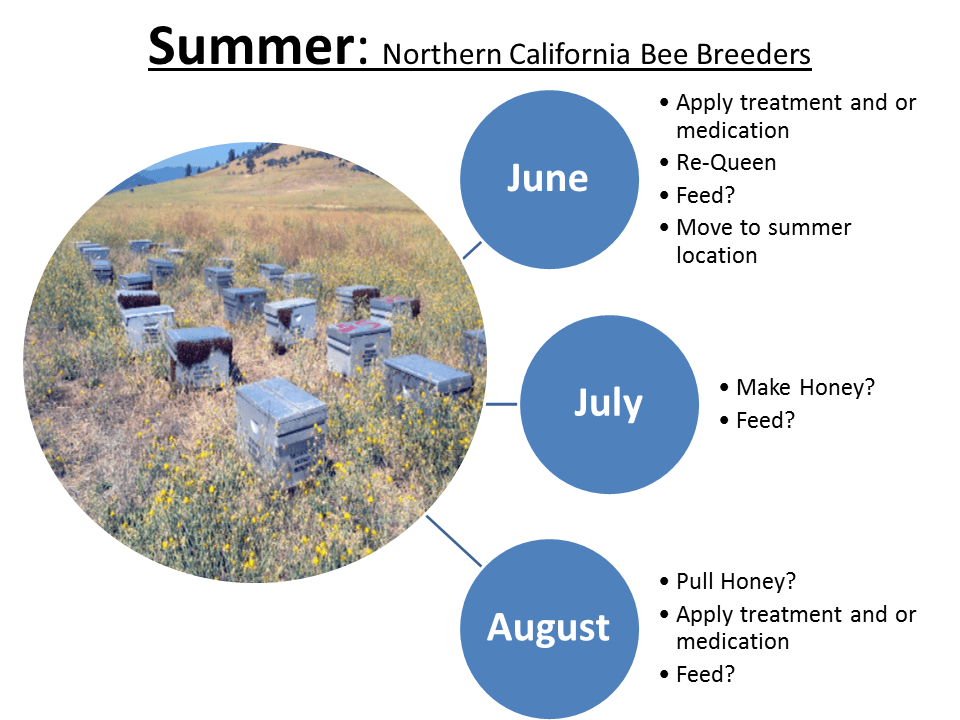
The graphic above illustrates the basic cycle of beekeeping during the summer season in northern California. Things like applying treatments and feeding are management decisions based on what the bees are doing in response to the environment around them. Feeding and treating is operation specific and location dependent.
Think of treatment windows in terms of hive dynamics with bee population being one of the most important. Hive populations go in cycles, rising in times where forage is abundant and falling at times when available forage tapers off. It is much easier to effectively treat a hive for Varroa and Nosema when bee populations are low then when they are high. Treating hives when populations are lower may allow you to use fewer treatments at lower doses over a shorter period of time. To reinforce this idea take into consideration that as bee populations grow so do mite and pathogen levels (the more brood and bees the more likely you are to have mites and pathogens). So, applying a treatment before a population boom is a good way of getting the most out of your applications. It is also very important to make sure that you are setting your hives up for over-wintering success by making sure that pest and pathogen loads are low going into the winter. There is also a lot to be said about breaking the brood cycle both in terms of pests and pathogens and the longevity of queens.
Feeding is mainly done to supplement the lack of natural forage available in certain locations at different times of the year. Supplemental feeding is an excellent way to manipulate hives in to doing what is you want them to do. When done correctly supplemental feeding helps maintain balance within the hive. Beekeepers should choose a supplemental feeding regiment that will help them achieve their goals for their hives. Remember that supplemental feeding is exactly what it says it is, supplemental. There is no substitute for good, healthy, natural forage. The best way to have good healthy strong winter bees in places where available forage has tapered off in the fall is to feed both syrup and pollen to ensure that the last cycle of developing brood going into winter has everything they need in terms of nutrition to ensure that they will be strong enough to last 3 months in the hive with what they have been able to store up throughout the summer.
Applying treatments and or medications during the summer months is mainly done in May or June at the end of most bee breeders breeding season and just before the star thistle nectar flow begins in July. Beekeepers who are producing honey will often slap a mite treatment in hives immediately after pulling honey supers and just before moving them to fall/winter locations. Once at their fall/winter locations beekeepers can inspect hives and deliver a clean-up treatment if they feel it’s necessary.
Out here most beekeepers will medicate their bees again in late August and early September then begin supplemental feeding at the end of September through October to give the last cycle of brood that extra nutrition they will need to get through the winter. If you are able to treat your bees early enough for mites in a place where it’s cold enough to break the brood cycle you are doubling your chances of reducing mite loads. After which, you could, if possible bring them to a semi-warmer fall/winter location where you are able to feed supplements to stimulate the queen into pumping out another cycle or two of well-developed mite free bees. Nosema levels out here in the fall seem to naturally decline on their own and some beekeepers feel they are able to get away without a Nosema treatment heading into winter. It is hard to know if you’re wasting time and money treating for Nosema if you are not testing your bees. It’s a good idea for any beekeeper to learn how to take samples and test bees for both Varroa and Nosema.
